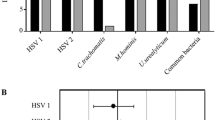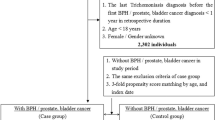Abstract
Early age at first intercourse, increased number of sexual partners, lack of circumcision and history of sexually transmitted diseases (STDs) are associated with prostate cancer. There has been no investigation of the effect of these factors on prostate health at an early age. Previously collected serum samples from STD clinic attendees were tested retrospectively for anti-chlamydial antibodies, and prostate specific antigen (PSA) concentration. Patients at an STD clinic were interviewed regarding age of first intercourse, number of sexual partners and circumcision status. This was compared to clinical diagnosis, anti-chlamydial antibody titre and PSA concentration. The results showed: (1) that of patients with an anti-chlamydial antibody titre equal or greater than 1 in 64 (n=27) 37% had a PSA concentration greater than 0.8 ng/ml while those with a titre less than 1/64 (n=201) only 17% had a PSA >0.8 (P<0.05). (2) No association was found with circumcision status. (3) Early age of first intercourse and more than 20 sexual partners were associated with a synergistic increase in mean anti-chlamydial antibody titre and a mean PSA concentration of 1.2 ng/ml (95% CI 0.56–1.76). It is concluded that these results provide the first evidence that sexual behaviour related risk factors for prostate cancer do damage the prostate at an early age. Though they do not prove that infection is a cause of prostate cancer they do justify further research into the specificity of agents involved and impact of antibiotic treatment.
This is a preview of subscription content, access via your institution
Access options
Subscribe to this journal
Receive 4 print issues and online access
$259.00 per year
only $64.75 per issue
Buy this article
- Purchase on Springer Link
- Instant access to full article PDF
Prices may be subject to local taxes which are calculated during checkout
Similar content being viewed by others
References
Manning J, Raymond A, Batsakis J Extraosseous ostoegenic sarcoma of the parotid gland. J Laryngol 1986 100 239–242
Eurogast Study Group T An international association between Helicobacter pylori infection and gastric cancer. Lancet 1994 341 1359–1362
Cuzick J et al. Association between high-risk HPV types HLA DRB 1* and DQB 1* alleles and cervical cancer in British women. Br J Cancer 2000 82 1348–1352
Key T Risk factors for prostate cancer. Cancer Surveys 1995 23 63–77
Oliver RTD Adjuncts for magnifying the effectiveness of intermittent hormone therapy in early and advanced prostate cancer. In: Belldegrun A, Kirby RS, Oliver RTD, (eds). New Perspectives in Prostate Cancer. ISIS Medical Media: Oxford 1998 325–336
Oishi K, Yoshida O, Schroeder F The geography of prostate cancer and its treatment in Japan. Cancer Surveys 1995 23 267–280
Walker AR et al Low serum prostate specific antigen levels in rural African men at low risk of prostate cancer. South Afr Med J 2001 (in press)
Oesterling J Prostate specific antigen: a critical assessment of the most useful tumour marker for adenocarcinoma of the prostate. J Urol 1991 145 907–923
Pansadoro V et al. Prostate specific antigen and prostatitis in men under fifty. Eur Urology 1996 30 24–27
Ostaszewska I et al. Chlamydia trachomatis: probable cause of prostatitis. Int J STD AIDS 1998 9 350–353
Treharne J, Darouga S, Jones B Modification of the microimmunofluorescence test to provide a routine serodiagnostic test for chlamydial infection. J Clin Path 1977 30 510–517
Grosskurth H et al. Control of sexually transmitted disease for HIV-1 prevention: understanding the implications of the Mwanza and Rakai trials. Lancet 2000 355 1981–1987
Author information
Authors and Affiliations
Corresponding author
Rights and permissions
About this article
Cite this article
Oliver, J., Oliver, R. & Ballard, R. Influence of circumcision and sexual behaviour on PSA levels in patients attending a sexually transmitted disease (STD) clinic. Prostate Cancer Prostatic Dis 4, 228–231 (2001). https://doi.org/10.1038/sj.pcan.4500535
Received:
Revised:
Accepted:
Published:
Issue Date:
DOI: https://doi.org/10.1038/sj.pcan.4500535
Keywords
This article is cited by
-
Identification of low oxygen-tolerating bacteria in prostate secretions of cancer patients and discussion of possible aetiological significance
Scientific Reports (2017)
-
A case-cohort study of human herpesvirus 8 seropositivity and incident prostate cancer in Tobago
Infectious Agents and Cancer (2011)
-
Prostate-specific antigen, sexual behavior, and sexually transmitted infections in US men 40–59 years old, 2001–2004: a cross – sectional study
Infectious Agents and Cancer (2007)



